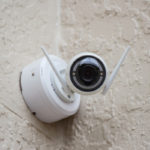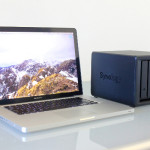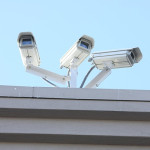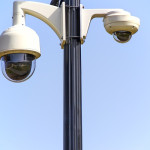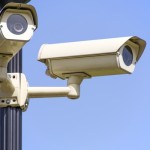What Is FRT?
By now, we have all heard about facial recognition technology and how it is becoming more commonplace in our everyday lives. But do you really know how it works and its benefits?
Facial recognition technology (FRT) analyzes the unique features of a person’s face to verify their identity. This advanced technology can be used as identification authentication to protect sensitive areas or information. As this technology continues to advance, we will see an increase in reliability and application.
Learn more about the different types of FRT:
- Traditional
Traditional FRT uses a photo or image of a face to analyze the basic geometry of the features. After analyzing, the features are cross-referenced against a database of different faces. - 3-Dimensional (3D)
A more sophisticated technology, 3D FRT uses 3D sensors and cameras at various angles. The 3D sensors capture the shape and contours of the face, while cameras capture traditional FRT data. Both data sets are merged to create a comprehensive understanding of the face, including different facial expressions. Then this data is cross-referenced with the database. - Surface Texture Analysis
Surface Texture Analysis takes an image of a patch of skin (also known as a skin print). The skin print is then segmented and turned into measurable space with complex algorithms. It is then analyzed for any lines, pores, or interesting characteristics. This technology is used in tandem with traditional and 3D FRT and can distinguish between identical twins. - Thermal
Thermal FRT uses more advanced cameras, but has the same basic concept as other FRT. This technology uses both traditional and thermal cameras to create facial recognition in low visibility scenarios.
As you can imagine, all the different types of FRT can be used to ensure heightened security in places housing highly sensitive data as well as keeping unknown persons away from private property. Share your own thoughts about FRT and its future with us on Facebook, Twitter, LinkedIn, and Pinterest.
Keep an eye on your property with quality security cameras from SecurityCamExpert.com. Let us help you choose the right surveillance system to suit your needs and we can take care of the installation, too! To learn more about our products and services, please call 888-203-6294.
What You Need To Know About Cloud Cameras
What are cloud cameras and why should you invest in them?
A cloud-based security camera, or cloud camera, is a security camera that is closely related to the IP camera. Both cloud and IP cameras connect to the internet, however, with cloud cameras, you need not assign IP addresses to each camera. Cloud cameras make it simple – all they need is a power cord and an Ethernet cable and you’re set. Cloud cameras will come with software or an app that enables streaming and remote camera management via smart device or computer.
On the upside, cloud cameras offer excellent benefits for users. First of all, these cameras are extremely easy to set up as they essentially plug-and-play. They are compact, affordable and accessible.
Cloud-based cameras also allow you to access your video feed virtually anytime from any place. While IP cameras can also provide this benefit, they require a bit more extensive set up to ensure proper performance and security.
In addition, cloud cameras boast automatic updates, device software improvements, and security vulnerability patching. Maintaining any additional hardware and software is no longer a worry.
With these advantages come some disadvantages. Cloud cameras come with monthly fees and limited functionality depending on how much you are willing to pay. And your provider may raise prices at any time, thus you must pay the higher price or purchase a different camera.
Privacy concerns and security risks are another factor, as your video feed is available on an external server. Also, because your cloud camera will be constantly sending data over the internet, it can slow down connection for other internet activities. For those in areas with slow service or data caps, cloud cameras may not be a feasible option.
The important thing to remember is that there are numerous security cameras with different features on the market. You should evaluate your needs and research different types of cameras to determine which type is right for you. If you need some help or have any questions, please feel free to contact us at 888-203-6294. You can also browse our selection of top quality security cameras at cost-effective prices online at SecurityCamExpert.com. Connect with us on Facebook, Twitter, LinkedIn, and Pinterest.
Summer Travel & Cyber Security
Whether you are traveling for business or pleasure, cyber security is important and essential. You should always do your best to safeguard your personal data, but business travelers should take extra precaution as both personal and business data may be at risk. Before you leave, be sure to review and apply these smart cyber security tips.
Lock Devices
Most devices (smartphones, laptops, tablets) have a security setting that enables you to lock your device using a PIN number or fingerprint ID. You should enable this on every device. In addition, you should change the PIN numbers you regularly use. Should your devices be temporarily misplaced or forgotten, this will be the first line of defense against a security breach.
Be Cautious Of Public Wi-Fi
If you are traveling abroad, the laws and regulations that govern cyber security are typically not the same as those in the United States. Although free Wi-Fi access can be very appealing, it can be particularly vulnerable to security issues.
Avoid any unencrypted Wi-Fi networks – ask the hotel about its security protocol before connecting. Be extra cautious using Internet cafes and free Wi-Fi hotspots. If you must use them, avoid accessing personal accounts or sensitive data while connected to that network.
Disable Auto-Connect
If your phone has a setting which allows your device to automatically connect to Wi-Fi networks as you pass through them, turn it off before you leave. It can be convenient when you are at home, but it is not something you should allow while traveling.
Disable Bluetooth Connectivity
Along with your Wi-Fi connectivity, you should also disable Bluetooth connectivity. Bluetooth signals can come from anywhere, and if left on, nearby assailants can connect to your phone and potentially hack into your device.
Minimize Location Sharing
When traveling, it may be tempting to share your experiences in real time on social networks. The problem with this is that it creates a security threat at home. Knowing where you are helps criminals determine that you’re not in your hotel room or at home, leaving these areas vulnerable to physical intrusion. Limit what you post online or save it until after you have returned home to minimize potential threats.
Install Anti-Virus Protection
One of the easiest and most effective ways to keep personal and company information secure while traveling is to utilize anti-virus protection. Choose a trusted brand of security and be sure to regularly update this software as new versions become available.
Update Operating Systems
Much like anti-virus software, your operating system should be kept up-to-date. This also applies to apps on your phone, especially those which you use regularly to conduct financial or personal business.
Update Passwords
Password management is ever important, so if you are going to travel, be sure to change all of the passwords you regularly use. If you must create a PIN for a safe or security box in a hotel room, make sure it’s unique and not something you commonly use. Don’t skimp on password creation either. Take the time to create something that will keep a criminal out of your personal property. Once you return home, you can changes all the passwords back.
In addition to these tips, you should also review the laws and regulations governing cyber security in each country you plan to visit. Be aware of your surroundings, networks, and devices to reduce the risk of cyber threats. Share your own cyber security tips with us on Facebook, Twitter, LinkedIn, and Pinterest.
For a comprehensive selection of quality IP and HD security cameras to suit your budget and needs, please visit SecurityCamExpert.com. For questions or to request a free quote, please call 888-203-6294.
Local Storage Options For Your Security System
There are plenty of aspects to consider when it comes to investing and installing a new security camera system. The goal is to deter any theft or crimes while capturing the necessary footage should an incident occur. With that said, aside from the security cameras you choose, your surveillance storage solution should be of high quality and capacity and tailored to your storage needs.
Storing your video footage locally makes it easier to access, and is usually easier to use. In addition, local storage options are much more cost-effective than other storage solutions. In terms of local storage, there are two main options: internal or external. Internal storage is saved within the camera whereas external storage is saved to a hard drive, usually located within a computer or CCTV DVR/NVR. Each option poses their respective advantages and disadvantages.
Internal Camera Storage
When you store your video footage internally, it is usually via a microSD chip within the camera. This option is ideal for those who don’t want to rely on internet access or wiring, as this can slow down your internet. In addition, since internal storage bypasses any transferring to external storage, video footage is nearly immediately available.
The biggest downside of internal storage is its limited storage capacity. In an effort to combat this, most security cameras using local storage only record when motion is detected. And these cameras are more vulnerable because the footage is stored internally, thus, if the camera is stolen, so is any video evidence that could be used to prosecute the thieves.
External Camera Storage
If you need to record footage throughout the day, external storage is a great option as you can store large amounts of video at a relatively low cost (especially compared to online storage.
Wired Camera Storage
Wired solutions will save your network a load of work and will be faster when watching live feed (minimal lag time). Typically, you will have some type of hub that encodes the recording, and then the wire will route to either a DVR (digital video recorder) or a personal computer with lots of storage space. If you plan on editing the video, personal computers are more convenient.
Unfortunately, wired security cameras are susceptible to severed wires. If you opt for a wired camera, you will want to embed the wire through the wall and make sure that your camera is securely mounted.
Wireless Camera Storage
If you opt for wireless cameras, you are choosing a very secure solution. These are also the easiest to install as you usually just plug it in, connect to a network and install software. Your video would be routed to either a personal computer or an NVR (network video recorder).
Unfortunately, wireless cameras are not ideal for smaller home wireless networks. They can slow down the internet and may be susceptible to delays in your video feed. Should you choose wireless solutions, just be sure that your network can handle the load.
While there is not a universal best storage solution, there are solutions that are better suited for you than others. Take the time to evaluate your needs to determine which storage solution would work best for you.
If you need help determining which video surveillance solution to choose, contact us at 888-203-6294 or browse our inventory online at SecurityCamExpert.com. You can also connect with us on Facebook, Google+, Twitter, LinkedIn, and Pinterest.
Important Night Vision Camera Features
Night vision security cameras are very helpful in providing around-the-clock surveillance for homes and businesses. Their ability to see in the dark is thanks to advanced IR (infrared) surveillance technology. However, when shopping for a night vision camera, simple wording such as “infrared (IR) illumination” and “night vision” is not enough. You want to look for specific features to ensure you are choosing the best night vision security cameras.
Three important features to look for include:
- IR cut filter
- Powerful Illumination
- Infrared Illuminators (ideally, these match the FOV (field of view) of the camera’s lens)
The quality of your night vision security camera will be determined by these features.
IR Cut Filter
Night vision security cameras with infrared cut-off filters improve image clarity (especially in daytime) and can prevent out of focus images. The way the filter works is quite simple, yet makes all the different in video and image quality.
The IR cut filter is physically moved over the lens when daylight (white light) is detected to block out the IR light (that would affect the image quality). When the light levels drop to the point where night vision is necessary, the camera will move the lens out of the way. This “filter switch” allows the camera to pick up the same colors as the human eye to record natural looking images and results in better images overall. Without these filters, there’s no way to prevent full-spectrum light, thus, daytime images would suffer from distortion and possible loss of focus.
Powerful Illumination (IR LEDs) Beam
Simply put – the more powerful the illumination, the better the night vision will be. For example, if you are looking for outdoor cameras, you want cameras that produce something in the neighborhood of 100 ft. of IR illumination.
Infrared Illuminators
Before discussing IR illuminators, the Field of View (FOV) should be understood. If you think of it in terms of binoculars, the field of view is everything you see when looking into them. What you cannot see is outside of the field of view. Often times, the infrared illuminators in a night vision security camera don’t match its FOV, thus the IR-beam is not illuminating the total area captured by the lens.
For the night vision cameras with an IR illuminator narrower than the FOV, you get a bright area in the middle of the image with the darkness growing as you get further from the center (ex. the spotlight effect). This is problematic as it makes it nearly impossible to identify areas outside of the center of the image. Finding a night vision camera with an IR illuminator that is equal to the FOV may cost more, but is well worth it.
Although seeking out specifications and ensuring that night vision cameras meet your expectations and requirements seems like a tedious task, it is well worth the security and peace of mind when it comes down to it.
Need help choosing a night vision security camera? Contact us at 888-203-6294 to discuss your options. You may also browse our stock of IR night vision cameras and other surveillance equipment online at SecurityCamExpert.com. For the latest updates, connect with us on Facebook, Google+, Twitter, LinkedIn, and Pinterest.
Building The Ideal CCTV Surveillance System
When it comes to securing your property, CCTV cameras can be very effective. However, because there are a wide variety of CCTV cameras suited for different applications, if they are not properly implemented, their effectiveness may be compromised.
Before choosing your surveillance system, review the different types of CCTV cameras and the application for which they are best suited.
Different Types Of CCTV
Dome Camera
- Commonly used for indoor surveillance
- The ambiguous shape & design acts as a deterrent as criminals are unsure which way the camera is facing
- Ease of installation
- Vandal-proof features
- Infrared capability
Bullet Camera
- Long, cylindrical shape ideal for long distance viewing
- Better suited for outdoor use
- Protective casings safeguard against dust, dirt, and other natural elements
- Compact size makes for easy installation and mounting with bracket
- Fitted with either fixed or varifocal lenses depending on the requirements of the intended application
- Adaptability (can be used indoors and outdoors)
- High quality image resolution
C-Mount Camera
- Detachable lenses allow for simple lens changes to fit different applications
- Specialized lens use allow these cameras the ability to cover distances beyond 40ft
- Can support changes in technology
- Effective for indoor use
- Bulky design and presence acts as a deterrent
Day/Night Camera
- Can operate in both normal and poorly lit environments
- They utilize extra sensitive imaging chips (instead of infrared illuminators)
- Ideal for outdoor applications in which IR cameras do not function optimally
- Record in both color and black & white
- Wide variety of sizes available
- IR (Infrared) capability
PTZ (Pan/Tilt/Zoom) Camera
- Used with live guard or surveillance specialist operating the security systems
- Pan and tilt rotation
- Smart tracking features
- Powerful zoom and autofocus
What To Consider
Choosing the right CCTV camera for your property is important. You want to evaluate your needs to determine where you will place these cameras as well as their primary use in that location. Some factors to consider when choosing include the lens, sensor, and output resolution.
- Lens
The lens will dictate the quality of the image. The appropriate lens will allow your camera to focus and bring in enough light to the sensor, providing clarity and the ability to better identify things such as faces and license plates. A zoom lens will allow for further detail since it can adjust the light as it reaches to sensor for enhanced pictures and flexibility.
- Sensor
There are two types of sensors:
- CMOS (complementary metal oxide semiconductor)
- CCD (charged coupled device) cameras
CCD are more expensive than CMOS and produce clearer images (ideal for identifying faces and license plates).
- Output Resolution
Generally speaking, the more pixels, the better the picture. The highest resolution you can get is 700TL, but most cameras range between 300-550TVL. Be sure to match a resolution that your camera can produce because anything more is unnecessary.
Other Things To Consider:
- Discreet Vs. Visible
Box cameras are easier to be seen and clearly tell passersby that they are being recorded, which acts as a great deterrent. Dome cameras, on the other hand, are smaller and more discreet, making them ideal for monitoring larger areas such as front or backyards.
- Indoors Vs. Outdoors
Consider where you will place your cameras both indoors and outdoors. If you plan on placing them outdoors, you want to ensure they are in the best location and well protected (weatherproof and vandal proof housing). For indoor cameras, you want to make sure it will not be affected by things like grease or steam from the kitchen.
- Lighting Conditions
Whether indoors or outdoors, lighting will always change so it is advised that you test different camera models to see what works best with your lighting conditions. You also want to check for any reflections or backlighting during day or night.
- Image Clarity
This will depend on the size of the area you want to monitor. Thus, a camera situated in a small room need not be of high resolution. The resolution of your CCTV camera should reflect the landscape in order to provide effective images.
- Audio?
This depends on your personal preference (you should also look into the laws regarding audio recording if applicable). Some CCTV systems allow you to speak to the intruders, or you can have audio or alarms sound automatically when they reach a certain point. These tactics are meant to scare the intruders away before they can cause damage.
If you need help choosing the right CCTV surveillance system, call 888-203-6294 and we will be happy to help! You may also browse our selection online at SecurityCamExpert.com and connect with us on Facebook, Google+, Twitter, LinkedIn, and Pinterest.
Motion Detection: How It Works
Security cameras equipped with motion detection can be very helpful for home and business owners. Motion sensor cameras allow users to rest easy knowing the built-in sensors will alert them when activity is detected, eliminating the need for monitoring live feeds around the clock.
While motion detection can be very convenient, it can also prove to be a nuisance. False alarms caused by various reasons, such as pets, natural environmental changes, or even changes in lighting, can be frustrating, confusing, and a waste of time. In order for you to make the most of the motion detection feature, here’s what you need to know.
Types of Detection
While there are many different technologies that detect motion (ex. light pulses, thermal measurements, radio waves), for consumer security cameras, there are two methods that are commonly used.
Passive Infrared (PIR)
This method detects the ambient heat emitted by all living beings and is sometimes referred to as “heat vision.” The sensor is triggered when it detects enough movement of these warm “objects” and/or a significant temperature disparity between the object and the background scene. When triggered, it signals the security camera to start recording, and thus, the user is alerted.
Computer Vision (CV)
This approach involves camera software that analyzes sequential frames of live video for differences and registers a motion event when a significant change is detected. With that said, CV includes many different methods, which depend on the desired outcome and technical preference of the designers.
Of these methods, one of the easiest involves looking for a significant change in pixels over short periods of time compared to the longer term average. This will produce a simple ‘something happened’ signal. Another method tracks groups of pixels and tries to identify directional patterns in order to recognize moving objects.
What all of these methods have is common is the end goal – to detect motion and, if possible, determine the shape of the object that moved. Once that goal is achieved, more advanced methods can be applied to classify the moving object (ex. person, animal, vehicle, tree) to determine which detection signals are important (ex. person or vehicle) or irrelevant and can be dismissed (ex. animal or tree).
Pros & Cons
- PIR sensors are more reliable than CV-based cameras when it comes to filtering out insignificant activity (ex. curtains fluttering in the breeze from a nearby fan, change in the light streaming through a window)
- PIR is power efficient, thus often used in battery-powered cameras. PIR keeps these cameras them in a low-power, non-recording state until the PIR sensor detects motion. When motion is detected, they switch to a high-power recording state for a fixed period of time (ex. to capture a 30 second video clip) or until motion stops.
- The low-power mode of PIR can be a disadvantage as it may take more time to wake up and start recording than CV-based cameras. Consequently, you may miss part of the action that triggered the motion alert, such as the intruder’s approach when their face is most visible, which matters with forensic evidence. By nature, they are also incapable of detecting motion through glass, thus are not suitable for scenarios such as monitoring your yard with an indoor cameras aimed through a window.
- CV motion detection provides greater analysis of the scene and for identification of the object creating motion through advanced features (ex. person detection, facial recognition). However many of the algorithms that make this possible are too computationally intensive to run locally on the camera. Instead, they are computed on remote servers in the cloud, where they often can only be unlocked with a paid subscription, which can add significantly to the total cost of ownership of the camera.
- Because CV detection is also dependent on the quality of the algorithms, it is also more susceptible to false alarms. That is, any large change (ex. spinning ceiling fan, leaves blowing outside window, change in ambient lighting) can register as motion.
False Alarms
Of course, false alarms are one of the most frustrating downsides to motion detection. Luckily, manufacturers are aware of this and offer different ways to reduce these instances.
- PIR cameras usually allow users to adjust the sensitivity level within the accompanying app so that more- or less-pronounced motion triggers the sensor. For example, reducing the sensitivity level could require a moving object to be warmer or closer to the camera for it to be triggered.
- CV offers more options for combating false alarms. A popular option is to set motion detection zones, which basically allows you to tell your camera to ignore activity in certain parts of the field of view while focusing on specific areas for motion. This approach is fairly effective as your camera can focus on windows and doors (where breaches are most likely to occur) rather than the activity within your home.
- Based on the geometric properties of a moving object, CV is able to make quick judgment calls. For example, something very small relative to the field of view is either a small object (ex. a floating dust mote) or a larger object far away, both of which are not cause for triggering any sensors.
- With more advanced technology, CV-based cameras may also include person detection or facial recognition to decrease false alerts. Both technologies require a pre-existing database of recognized individuals and usually require a few weeks of use before accurate results are produced. And while these features are advanced, they are only as strong as the algorithms behind them (which is why different cameras with facial recognition can produce different results).
Motion detection is still a work in progress, and at this point, you likely get what you pay for. The good news is that our technologies are always improving, thus, motion detection has the potential for greatness on the future.
What are your thoughts on motion detection security cameras? Have you had success or failure with them? Share your experiences with us on Facebook, Google+, Twitter, LinkedIn, and Pinterest.
Visit SecurityCamExpert.com to browse our wide selection of affordable CCTV security cameras and surveillance packages. Call 888-203-6294 to request a site survey or free quote today!
The Benefits Of PTZ Cameras
Looking back, Pan Tilt Zoom (PTZ) cameras have come a long way. As technology as has advanced, PTZ cameras have decreased in size and weight while offering even better features and functions.
These high-quality PTZ cameras are ideal for monitoring large, open spaces both indoors and outdoors. Some examples include casino, malls, airports, and stadiums, where effective and efficient surveillance is necessary.
As with any security system, selecting the right PTZ camera system comes down to individual security needs. Here are some important features to consider when choosing PTZ cameras.
Video Analytics
Now nearly all PTZ systems are equipped with video analytics which provide numerous benefits:
- Directional Behaviors – notify operators or active cameras when someone or something moves against the designated flow of traffic (ex. someone trying to walk into an exit path).
- Abandoned Object Behaviors – enables video system to alert security personnel when an object (ex. backpack, box, or briefcase) is set down and left unattended.
- License Plate Recognition, Facial Detection, Perimeter Detection & related analytics.
- Tripwire Behavior – activates a camera or triggers an alarm or other operations when a person or object moves into a restricted area.
Auto-Tracking
Arguably one of the most valuable features of PTZ cameras, auto-tracking controls the PTZ actions of a camera to automatically track (keep in field of view) an object in motion. This can be triggered manually or automatically by defined rules. Once a rule is triggered, the camera automatically zooms in and tracks the defined target.
Advanced Video Compression
The H.265 compression standard enables much higher compression ratios with lower bandwidth and storage requirements than before, providing higher resolution images and deeper systems integration. However, optimized implementations of the H.265 codec are emerging, like the Smart H.265+. In comparison to the standard h.265 video compression, Smart H.265+ reduces bit rate and storage requirements by up to 30 percent.
High-Definition Video Over Coax
Legacy coax systems can be easily upgraded to HD video using existing analog infrastructure thanks to HD video over coax. With this option, there is no latency in system responsiveness and no video compression, so the images maintain a high level of detail without stretching or distortion. In addition, there is no need to install a separate cable to control PTZ since coaxial cable allows for bidirectional data transfer. Overall, this is a cost-effective way to upgrade PTZ cameras.
Infrared (IR) Illumination
With PTZ cameras, IR illumination is applied as needed. There is usually an array of three distinct areas of infrared illuminators – each with a different angle of dispersion for the IR light: wide angle, telephoto, and interim angle.
As an example, when an operator optically zooms in from wide angle to telephoto, IR illuminator LEDs will turn on and off to provide the appropriate illumination. And when the camera is in zoom mode, it adjusts the IR illumination so that the system is not flooding the entire 120-degree view. These automatic modifications illuminate the area in view, producing better video and reducing the amount of power required.
Video Quality Expectations
Zoom Factor vs. Focal Length – Keep in mind that a higher zoom factor does not always provide a better video image. The focal length of the lens will provide a better indication of what is appropriate for an application.
Plastic vs. Glass – Remember not all lower domes (the protective housing at the bottom of a PTZ camera) are the same. While most manufacturers use a plastic lower globe to protect the camera and optics, this can offer a lower degree of optical clarity. As the camera pans up toward the horizon, it begins to view through the globe in areas where it has the least uniformity (where most optical distortions can occur).
Glass lower globes (or a flat piece of glass, as provided by some companies) are more optically pure and consistent in comparison. These glass coverings enable dome systems to feature higher resolution sensors and longer optical zooms thanks to their clear and consistent nature.
Some modified lower dome designs allow for above-the-horizon viewing – ideal for those who need to monitor rough terrain or scenes on different planes of view.
Thinking about installing a PTZ system on your property? We carry a great collection of quality PTZ security cameras. Browse our stock online or call 888-203-6294 to request a site survey, free quote, or inquire about our installation services. Connect with us on Facebook, Google+, Twitter, LinkedIn, and Pinterest.
Security Camera Image Sensors: CCD Vs. CMOS
Choosing the best security camera system can be based on many factors. When it comes to the individual security cameras, the quality of images and video captured is largely dependent on the image sensor.
The image sensor (also known as the “eye”) determines the imaging capability and performance of your security camera. Their duty is to convert an optical image into an electrical signal, and is either a charge-coupled device (CCD) or a complementary metal-oxide semiconductor (CMOS) active pixel sensor.
To better understand which type of image sensor will work best for your security camera needs, we will take a look at the differences between CCD and CMOS.
What Is A CCD Image Sensor?
CCD’s receive light and convert it to electrons, then carry the electrons to a specific area across the chip to be processed. The conversion of analog light signals into digital pixels takes place in the chip without distortion. The special manufacturing process of CCD’s produces high-quality sensors in terms of fidelity and light sensitivity.
What Is A CMOS Image Sensor?
The CMOS sensor came from the MOS active pixel image sensor which emerged in the 1960s. Since then, its design and function has greatly improved, containing integrated circuitry and arrays of pixel sensors. Unlike the CCD, CMOS sensors process the elections at the same place that it receives the light, thus making it faster and smaller. The CMOS is able to do so because it has multiple transistors at each pixel, offering flexibility because each pixel is treated individually.
CCD vs. CMOS
Now that we have covered the basics, we can compare the strengths and weaknesses of CCD and CMOS cameras.
- CCD cameras provide high-quality images with low noise (grain), whereas CMOS cameras are more susceptible to noise. CMOS cameras often need more light to create a low noise image at proper exposure.
- CCD cameras possess better light sensitivity than CMOS cameras, since the CMOS sensors have more transistors next to each pixel, which may interfere with the amount of light that reaches the photodiode (where the picture is processed).
- CMOS sensors consume less power since the processes are confined to a smaller area. CCD sensors consume as much as 100 times more than CMOS.
- CMOS chips require a simple and traditional manufacturing process (same as creating microchips) making them easier to produce and much more affordable than CCD. As mentioned, CCD sensors require a special manufacturing process which makes them more expensive.
Common Applications
In these common applications, one camera outshines the other.
- Because of their superior light sensitivity and large effective imaging area, CCD cameras are better suited for low light conditions than CMOS cameras.
- Since the CMOS image sensor is compact, CMOS cameras are better for hidden or covert surveillance.
- Choose CMOS cameras for high-frame speed video shooting since the CMOS image sensor has a very fast processing speed (thanks to its ability to directly convert photoelectric signal to digital signal).
Which type of security cameras do you prefer? Share with us on Facebook, Google+, Twitter, LinkedIn, and Pinterest.
To shop our stock of security cameras and surveillance equipment, including CMOS cameras and CCD cameras, visit SecurityCamExpert.com. If you are located in Southern California and would like to schedule a site survey or request a free quote, please call 888-203-6294.
Transitioning From Analog Security Cameras To IP Surveillance
Upgrading your analog security cameras to IP security cameras has plenty of benefits, including improved image quality and advanced features. Most IP surveillance systems can make use of existing network infrastructure that is in good condition, decreasing costs for installation. Whether you are looking to upgrade because your analog system is reaching end-of-life for support or because your needs have changed, an IP surveillance system is a smart decision.
Now, the actual task of transitioning from analog to IP security cameras should not be taken lightly. You want to be sure that you take all things into consideration to ensure that you choose the right IP video surveillance system and that it performs sufficiently. Here are a few aspects you should not overlook:
Goals & Challenges
If you are looking to achieve ROI, you must fully understand how your IP security system will be used. Operational goals and potential challenges should be determined beforehand. Think about what types of cameras and how much resolution you need, as well as how long the footage needs to be stored and which areas need coverage. Proper planning is crucial to the success of your security system.
Budgets
No one wants to pay an arm and a leg for a mediocre surveillance system. If done correctly, you don’t need to. By defining a security budget, you can find the right cameras and video management software (VMS) to fulfill your needs and achieve your goals.
Time
As much as a quick transition sounds ideal, it is not always feasible. Understand that a proper transition will take some time, and it may be in your best interest to plan a phased migration. This will help to accommodate budget availability and operational disruptions. Prioritize which area needs immediate attention and begin there.
Storage
Going from analog to IP improves video quality, but also requires more storage. Advanced VMS can help to effectively optimize your network resources and bandwidth consumption, thus decreasing networking and storage costs over time.
Staffing
A new IP video system may need additional staffing, so you should think about this and how you will train the new and existing staff. This will impact both overall costs and ROI of your system, and may affect cameras and software selection. For example, casinos require live monitoring around the clock while parking lot surveillance may use video analytics to alert security personnel of incidents or events that need attention.
Integration
Numerous third-party integrations can help to increase the efficiency of your system as well as manage costs. While most current systems have an IP-based interface for integration, leading suppliers also have a wide range of integrations which are tested and ready to apply. These can offer functionality, automation, and other enhancements to solve project needs.
Cybersecurity
Cybersecurity is of utmost importance, especially these days. If not addressed properly, going from analog to IP opens up your system, and any indirectly connected networks, to endless vulnerabilities. Be sure to discuss your specific network safeguards, policies, and strategies with your installer. Also, enlist a new IP security system that provides the appropriate cybersecurity architecture, software, devices, and policies.
Licensing
Pay attention to licensing requirements and Software Upgrade Plans (SUPs) or Service Level Agreements (SLAs) that come with most VMS systems. These cover everything from higher tiers of support to future upgrades. For example, third-party cameras may require a license for each IP address, and these licensing requirements can add additional costs.
Environmental Conditions
These include extreme heat or cold, humidity, corrosion, and high dust levels, along with ambient light levels, existing power sources, and network infrastructure. All of these can impact which security cameras and VMS equipment are necessary for you.
Redundancy
Because your security system should be operational and accessible at all times, it is important plan provisions for redundancy and back up for primary resources in case they fail. For most systems, simple RAID-5 or -6 redundancy in storage is sufficient. However, you should also consider budgeting for “failover” recorders and other server hardware, and have spare cameras on hand in case of failure.
It is only a matter of time until IP surveillance is the norm and analog security cameras are a thing of the past. But when the day comes, it is ever important to understand your security needs and what you expect from your IP surveillance system. Even a small mistake or misstep along the way can compromise your system.
Have you upgraded to an IP security camera system? Share your stories with us on Facebook, Google+, Twitter, LinkedIn and Pinterest. You can shop our selection online at SecurityCamExpert.com or call 888-203-6294 to inquire about our products, installation services, or request a free quote!

